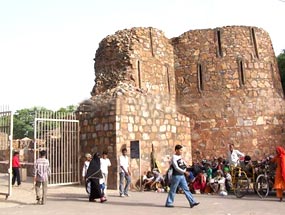Location: Bahadur Shah Zafar Marg, Delhi
Founded By: Firoz Shah Tughlaq
Founded In: 1354
Architects: Malik Ghazi and Abdul Hakk
Feroz Shah Kotla was the erstwhile citadel of Ferozabad, the Fifth city
of Delhi. It is situated off the Bahadur Shah Zafar Marg of Delhi, near
the Feroz Shah Kotla Cricket Stadium. Emperor Firoz Shah Tughlaq, the
nephew of Ghiyasuddin Tughlaq and successor of Muhammad Tughlaq, got the
citadel of Ferozshah Kotla built in the year 1354. Along with the
citadel, he also laid the foundation of the city of Ferozabad. The city
and its citadel were designed by the famous architects, Malik Ghazi and
Abdul Hakk.
During that time, Feroz Shah Kotla was popularly known as
Kushk-I-Feroz, meaning Feroz's palace. The city of Ferozabad extended
from Hauz-Khas in the southwest to Pir Ghaib in the north. The Firoz
Shah Kotla citadel of India comprises of three rubble-built walled
rectangular enclosures. The design of the citadel looks like an
irregular polygon, which has the eastern wall in one alignment. The
eastern wall of Feroz Shah Kotla was constructed on the embankment of
River Yamuna.
It is believed that Emperor Firoz Shah Tughlaq had three other palaces
in Delhi, when he began the construction of this citadel. The reason for
its construction was that the all the other palaces were facing a
shortage of water. Of the three enclosures of Feroz Shah Kotla, the
largest enclosure is the central one. It is presently known as 'Kotla
Feroz Shah' and has an impressive main gateway in the western direction.
On either side of the gateway are fortresses, which lie mainly in ruins
today.
Ferozshah Kotla is at times compared with the 'Windsor Palace of
London'. In its glorious days, the citadel was the perfect example of
architectural beauty. However, it was abandoned in the year 1490 and
since then, it has been lying mostly in ruins. The successive rules of
Delhi used most of its ruins for the construction of other cities.
However, even after being in neglect for many years, Firoz Shah Kotla
still has many interesting structures within its premises and is visited
by tourists in large numbers.
Ashokan Pillar
There is an Ashokan Pillar situated inside the premises of the citadel,
which lies to the north of Jami Masjid. The pillar dates back to the 3rd
century BC and rises to a height of 13 m. It is a sandstone structure
and stands on a rubble-built three-tired pyramidal structure. Emperor
Feroz Shah Tughlaq got the pillar, which weighs 27 tonnes, transferred
from Topar (Ambala) to Delhi. Another pillar, quite similar to the
Ashokan Pillar, was also brought by Feroz Shah Kotla and it was fixed on
the ridge.
Ashokan Pillar has been carved with seven main inscriptions or edicts
of Emperor Ashoka. Apart from that, there are numerous figures and minor
inscriptions engraved on the pillar. The edicts were written in the
Brahmi script of Pali language and were first deciphered by James
Prinsep in 1837. The pillar is made of sandstone. However, it was
polished in such manner that even today it looks as if it has been made
up of some metal. Since Feroz Shah adorned the pillar during his rule,
it came to be known as 'Minar-i-Zarin'.
Jami Masjid
Jami Masjid is situated next to the Ashokan Pillar in the citadel of
Feroz Shah Kotla. The structure that once made up the mosque has today
been reduced to the southern and western walls with the gateway. Jami
Masjid was one of the largest mosques of the Tughlaq period and rests on
a series of cells on the ground. It is still in use today. However, most
of the structures of the mosque, including the prayer hall as well as
the walkways, situated on the sides of the courtyard that was used by
the royal ladies, have vanished.
The mosque is made of local quartzite stone and is entered from the
northern side. At one point of time, Jami Masjid was connected to the
citadel by a bridge. It is said that, in the past, there was an entrance
to the mosque from the underground cells also. So great was the beauty
of the mosque that Timur constructed a similar mosque at Samarkand in
Iran. In the year 1759, the mosque became the site of the murder of
Emadul Mulk, the prime minister of the Mughal Emperor Alamgir Sani, by
his own emperor.
Baoli
As you move towards the northwest of the Ashokan pillar, you will come
across a garden. In the center of the garden is situated a large
circular baoli or step well. Apart from subterranean apartments, the
baoli also has a large underground drain for the water towards its
eastern side. The baoli was only used by persons of royal lineage and
used to serve as a cool haven during summers.
Other Structures
The other structures inside the Feroz Shah Kotla include the foundation
structure of a square hall. It is situated behind Ashokan Pillar, to the
north of Jami Mosque. Then, there are ruins of many other structures,
which have not been identified as yet, since they are in a very decrepit
shape.
